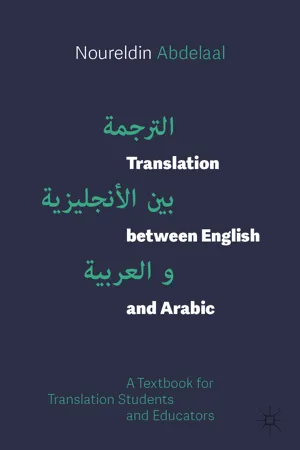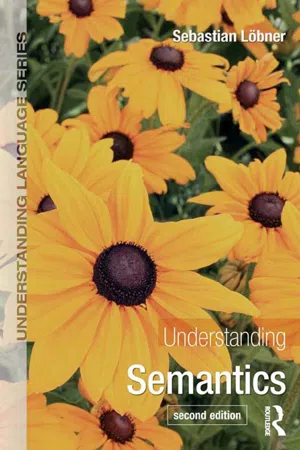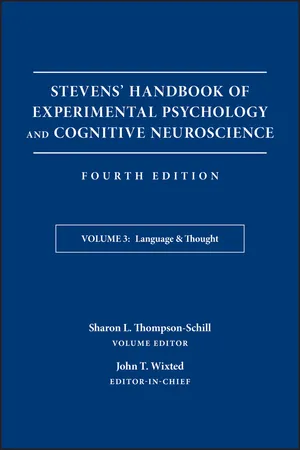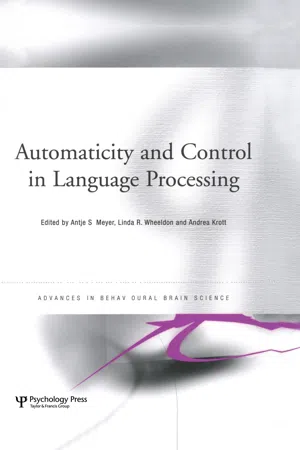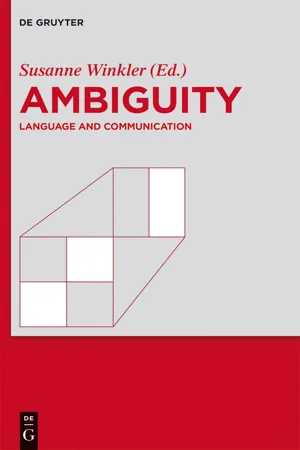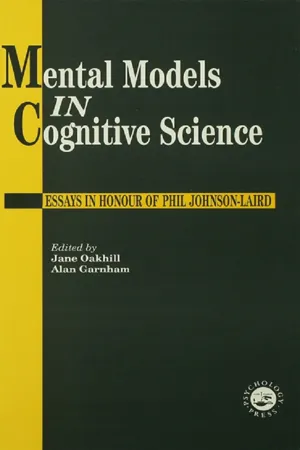Languages & Linguistics
Lexical Ambiguity
Lexical ambiguity refers to the presence of multiple meanings for a single word or phrase. This ambiguity can arise due to different interpretations, contexts, or word usage. It can lead to confusion or misunderstanding in communication, and is an important consideration in linguistics and language processing.
Written by Perlego with AI-assistance
Related key terms
7 Key excerpts on "Lexical Ambiguity"
- eBook - ePub
Translation between English and Arabic
A Textbook for Translation Students and Educators
- Noureldin Abdelaal(Author)
- 2020(Publication Date)
- Palgrave Macmillan(Publisher)
Linguistic ambiguity in translation can arise from ambiguity in the ST. If a translator fails to identify and resolve such ambiguity, or due to a lack of full understanding of the ST and the context of its situation, a translator may create an ambiguous translation. Among the various linguistic ambiguities mentioned by Newmark, Lexical Ambiguity is the most problematic. Lexical Ambiguity can be divided into two main categories; one holds that words have Lexical Ambiguity prior to their semantic occurrence in a text; the other considers that Lexical Ambiguity is context dependent, which means that it occurs due to the effect of the text (Simpson, 1981). Lexical Ambiguity can result from either homonymy or polysemy (Newmark, 1988). Examples of problems in translating polysemous and homonymous words are discussed in the following sections. 4.3 Lexical Ambiguity : Polysemy and Homonymy Newmark (1988) argued that Lexical Ambiguity is one of the ambiguities that cannot be easily resolved. Such ambiguity mainly arises from polysemy, homonymy, or metaphorical vs. literal meanings. Lexical Ambiguity is very common in language, as a single string of words may lead to more than one interpretation due to one of the words having more than one meaning: polysemy (Klepousniotou, 2002 ; Simpson, 1981). However, polysemy can be confused with homonymy, in which two words with the same spelling or pronunciation have two different meanings. According to the generative lexicon approach, homonymy ensues when discrete senses are stored separately, whereas, in polysemy, only the elementary meaning is stored in the lexical repertoire of the language user (Klepousniotou, 2002 ; Klepousniotou & Baum, 2005). In other words, polysemy refers to a multiplicity of meanings such as when one word is used in different fields with different meanings (Geeraerts, 2010) - eBook - ePub
- Sebastian Loebner(Author)
- 2013(Publication Date)
- Routledge(Publisher)
3Ambiguity
In dealing with meaning in the previous chapters, expressions were treated as though they had only one meaning (though possibly composed of different dimensions). This is, of course, not the case. Many, if not most, words have more than one meaning and even complete sentences may allow for several readings. The technical term for this phenomenon is ambiguity: an expression or an utterance is ambiguous if it can be interpreted in more than one way. The notion of ambiguity can be applied to all levels of meaning: to expression meaning, utterance meaning and communicative meaning. In dealing with ambiguity, we will first turn to the level of lexical meaning. This is in accordance with the general bottom-up perspective on interpretation taken in this book (1.2 , 1.3 ).3.1 LEXEMESIn 1.2.1 we distinguished lexical meaning from compositional meaning. Lexical meaning must be learned and stored in our mental lexicon; compositional meaning is the meaning of composite expressions and is derived ‘on demand’ from the meanings of the components by applying general semantic rules. Those linguistic units which carry lexical meanings are called lexemes. Typically, lexemes are single words, but there are also composite expressions with a special lexicalized meaning. Therefore ‘lexemes’ cannot just be equated with words. Examples of composite lexemes are so-called idioms like throw in the towel meaning ›give up‹ or fixed adjective-noun combinations such as white lie , broad bean or little finger . Composite lexemes need not be idioms like the ones mentioned. Less spectacular cases are particle verbs such as give up , fill in , look forward to , put on , figure out , etc.Lexemes are stored in the lexicon of the language, a huge complex structure in the minds of the language users. Lexical meaning is not to be confused with the meaning you may find in a dictionary. Dictionaries describe the meanings of their entries by means of paraphrases. For example, you may find the meaning of bird described as ‘feathered animal with two wings and two legs, usually able to fly’ (New Oxford Dictionary of English ). In order to understand the description, you have to know what these other words, feathered , animal , etc. mean. If you look these up in turn, you will find yet other words used for their description. Dictionaries are in this sense circular. No matter how carefully they are compiled, they will always contain an irreducible set of words the meaning of which is not, in fact cannot be, explained in this way. By contrast, the lexical meanings we have in our mental lexicons are not - eBook - ePub
- (Author)
- 2018(Publication Date)
- Wiley(Publisher)
For example, effects that are shared across different tasks are taken as an index of lexico-semantic or conceptual processing (Hoenig, Sim, Bochev, Herrnberger, & Kiefer, 2008; Yee & Thompson-Schill, 2016). Context-invariance has been argued to be essential for a healthy, functioning semantic system (Lambon-Ralph, 2014; Patterson, Nestor, & Rogers, 2007; Woollams, 2012). Under this assumption, context is extraneous stuff that happens when a word is used; thus it needs to be integrated with packets of word meaning (e.g., Hagoort, Baggio, & Willems, 2009). In the “Putting Words in Context” section, we will discuss context more in depth and its implications for word representation and processing. PROCESSING SEMANTICALLY AMBIGUOUS WORDS The link between wordforms and meanings is not a one-to-one mapping: Many words are polysemous (i.e., having multiple related meanings or senses, e.g., paper) and some words are outright ambiguous (i.e., having unrelated meanings, e.g., bark). It is estimated that about 80% of the words in English are semantically ambiguous (Parks, Ray, & Bland, 1998; Rodd, Gaskell, & Marslen-Wilson, 2002). The prevalence of meaning ambiguity in the lexicon means that comprehenders will need to constantly select among alternative meanings for a word. Thus, ambiguity has long been considered to provide a window into the processes underlying the successful comprehension of a word. Researchers have been debating how this process is carried out: Do people resolve the meaning of an ambiguous word by first accessing all its alternative meanings and then settling on one of them, or do they access the meanings one by one? How does linguistic context modulate this meaning selection process? Two main issues have been focused upon in the research - eBook - ePub
- Antje Meyer, Linda Wheeldon, Andrea Krott(Authors)
- 2007(Publication Date)
- Psychology Press(Publisher)
polysemous, then the similarity of meaning suggests that the ambiguity is probably conceptual, like those outlined below). “Iraqi head seeks arms” is another case where homophony causes ambiguity (twice), this time in a sentence context. Other forms of linguistic ambiguity include syntactic ambiguity (e.g., “Stolen painting found by trees”) or segmentation ambiguity (“a back” vs. “aback”). Each of these is an example of a full ambiguity. Examples of temporary linguistic ambiguities include the above-described garden-path effects, in which a syntactic ambiguity is resolved by subsequent syntactic information.In contrast to linguistic ambiguity, conceptual ambiguity arises because of the way the conceptual world is divided up by language. Most relevantly, natural language describes categories of objects with individual words. This means that if more than one specific instance of a category is available, an individual word can apply to all of those instances and will therefore be ambiguous. For example, imagine a situation where a speaker wishes to individuate a cantaloupe in the context of another smaller cantaloupe. Here, the label “cantaloupe” is ambiguous, because the two ambiguous referents—the two cantaloupes—share meaning, and therefore share a potential label. This represents conceptual ambiguity. Like linguistic ambiguity, conceptual ambiguity may be either full or temporary. Naming a cantaloupe “cantaloupe” in the context of a smaller cantaloupe is fully ambiguous; naming it “a cantaloupe that is larger” is temporarily ambiguous, with the critical point of ambiguity beginning immediately after the word “cantaloupe”.The distinction between conceptual and linguistic ambiguities can also be described representationally. Conceptual ambiguity arises representationally at the level of meaning. For example, the representations of the meanings of “larger cantaloupe” and “smaller cantaloupe” converge on a single representation of the meaning of cantaloupe-in-general, and this convergence at the level of meaning corresponds to the ambiguity. Linguistic ambiguity, in contrast, arises not at the level of meaning but instead at the level of linguistic form. Flying mammals and instruments for hitting balls are as distinct in meaning as any two meanings in the language. The only place these meanings converge is at the phonological representation /bæt/. A similar analysis applies to “Stolen painting found by trees”, “/əbæk/”, or “The weary traveller claimed the luggage . . .”. - eBook - ePub
- Susanne Winkler, Susanne Winkler(Authors)
- 2015(Publication Date)
- De Gruyter(Publisher)
a priori argument for avoiding ambiguity and the empirical evidence that people do not do so. Finally, section 5 provides some brief pointers for future research questions relating to ambiguity.2 Types of Ambiguity
Ambiguity must be distinguished from vagueness, although it is not always easy to decide whether a specific case of unclear meaning is one or the other. Ambiguous expressions have more than one distinct meaning; vague expressions have a single meaning that cannot be characterized precisely. (It is of course possible for an expression to be both ambiguous and vague, if it has multiple meanings, at least one of which cannot be made precise). If expressions are thought of as picking out regions in some semantic space, then ambiguous expressions pick out more than one region, whereas vague expressions pick out regions with fuzzy boundaries.To illustrate this distinction consider the word trillion. According to Dictionary. com, trillion can denote either 1012 or 1018 ; thus, it is ambiguous. There is also a vague usage, meaning, simply, ‘a very large quantity’.A more typical case is the standard example (at least among philosophers of language) of an ambiguous (polysemous) word, namely bank . It is usually discussed as though it had exactly two well-defined meanings: ‘financial institution’ (of a particular kind) and ‘edge of a river’. A quick glance at an English dictionary reveals that it has many more definitions; Dictionary.com lists 30. Many of these are very closely related, and could be argued to be subcases of a single meaning (e.g. “an institution for receiving, lending, exchanging, and safeguarding money” and “a special storage place: a blood bank; a sperm bank ”), and some are certainly vague (“a long pile or heap; mass: a bank of earth; a bank of clouds - eBook - ePub
Mental Models In Cognitive Science
Essays In Honour Of Phil Johnson-Laird
- Alan Garnham, Jane Oakhill(Authors)
- 2013(Publication Date)
- Psychology Press(Publisher)
Just as the original book began with perception and moved slowly into language, this chapter begins with broad psychological considerations and moves slowly into some linguistic consequences. As will quickly become apparent, I regard the human ability to cope with polysemy as a basic cognitive skill. The skill involves the use of context in ways that must be closely related to the ways people formulate mental models of discourse. It seems doubly appropriate, therefore, to offer it for inclusion in a book devoted to matters near to the heart of P.N. Johnson-Laird.Multiple MeaningsOne of the most interesting aspects of the lexical component of language is polysemy. “Lexical polysemy” is a polysyllabic way of saying that a word can be used to express more than one meaning. I will discuss polysemy, but first I want to make a case that polysemy is not limited to words. It is not even limited to language. Multiplicity of meaning is a very general cognitive phenomenon. Words simply provide one good place to study it.As I have puzzled over lexical polysemy it has struck me many times that words and acts have many similarities. Both involve an association between a tangible form—a sound or action—and an intangible meaning—a sense or purpose. In the linguistic case, however, tools of representation and analysis are more developed and standardised than in the nonlinguistic case. I would never claim that behaviour is nothing but a text, but I do believe that there are enough similarities to make the comparison worth pursuing. In particular, there is polysemy in both cases: the same tangible form can be associated with different meanings in different contexts. It has occurred to me, therefore, that our capacity to handle multiple linguistic meanings may be a special case of some general capacity to deal with multiplicity of meanings.The most interesting aspect of this multiplicity is that it seldom causes any problems. You might think that it would. Something that can have multiple meanings is potentially ambiguous—that is to say, there is always a possibility of selecting the wrong meaning and so being misled or confused. Consequently, when we want to communicate very precisely, we try to avoid terms that are subject to such ambiguities. In developing scientific terminology, for example, we try not to use the same symbol to mean two different things. But under the uncontrolled conditions we loosely call “everyday life”, multiplicity of meaning abounds—and only rarely does it result in any trouble or misunderstanding. - eBook - ePub
Idioms and Ambiguity in Context
Phrasal and Compositional Readings of Idiomatic Expressions
- Wiltrud Wagner(Author)
- 2020(Publication Date)
- De Gruyter(Publisher)
Through carefully shaping the linguistic context preceding and following a phrase with the potential for ambiguity, the speaker may determine whether this potential is realized at all and which reading(s) the hearer processes. He may also trigger a process of reanalysis, if the preceding context and the following context favour different readings.The most obvious use of the linguistic context to disambiguate is the application of metalinguistic strategies. Only rarely are metalinguistic strategies used for ambiguation. These strategies include the giving of the two (or more) possible readings, explanations of the intended meanings, or the use of paraphrases next to the phrase in question, without pointing out that they are paraphrases.Often, the processing is influenced less directly by the hearer’s knowledge of the language system, e.g. knowledge of syntax and semantics. Sometimes syntax influences the possible readings. In the English language it is not uncommon for a noun and a verb to be indistinguishable, as there is no capitalization as in German. Only the immediate linguistic context may distinguish between the readings through differences in the syntactic structure. Also, an uncommon syntax may sometimes be a sign for fixed phrases (see 1.2 ). Furthermore, semantic knowledge plays an essential part. Language users have to be aware of the conventional meanings of words. The comparable frequency of possible readings may also influence the preference for one or the other, thus knowledge of the respective frequency is also part of the relevant language knowledge. Additionally, different readings may have different requirements for semantic roles: while the compositional reading of “kick the bucket” requires an agent (someone who kicks), the phrasal reading requires a patient (someone who dies). Knowledge of frequent collocates and typical co-occurrences also influences the processing of language. With the “draw the drapes”-example discussed above, the reading “pull over the window” depends on the co-occurrence of “draw” with a curtain, cloth, veil, or a similar object. In a similar way, the co-occurrence of words determines the meanings these words may have in this particular context. For example, lay in co-occurrence with law (“lay down the law”) has a different meaning than in co-occurrence with egg (“lay an egg”). The effects of co-occurrences of certain words may change the salience (see below, social context) or have a priming
Index pages curate the most relevant extracts from our library of academic textbooks. They’ve been created using an in-house natural language model (NLM), each adding context and meaning to key research topics.
